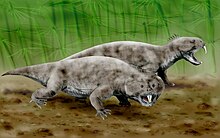Rhynchosaur
| Rhynchosaurs Temporal range:
| |
|---|---|

| |
| life restoration of Hyperodapedon | |
| Scientific classification | |
| Domain: | Eukaryota |
| Kingdom: | Animalia |
| Phylum: | Chordata |
| Class: | Reptilia |
| Clade: | Archosauromorpha |
| Clade: | Crocopoda |
| Order: | †Rhynchosauria Osborn, 1903 |
Rhynchosaurs were a group of Triassic diapsid reptiles related to the archosaurs.
Description

Rhynchosaurs were herbivores, and at times abundant (in some fossil localities accounting for 40 to 60% of specimens found), with stocky bodies and a powerful beak. Early primitive forms like Mesosuchus and Howesia were more typically lizard-like in build, and had skulls rather similar to the early diapsid Youngina, except for the beak and a few other features.
In later and more advanced genera the skull is short, broad, and triangular, becoming much wider than long in the most advanced forms like Hyperodapedon (= Scaphonyx), with a deep cheek region, and the premaxilla extending outwards and downwards to form the upper beak. The broad skull would have accommodated powerful jaw muscles. The lower jaw was also deep, and when the mouth was closed it clamped firmly into the maxilla (upper jaw), like the blade of a penknife closing into its handle. This scissors-like action would have enabled rhynchosaurs to cut up tough plant material.
The teeth were unusual, those in the maxilla and palate modified into broad tooth plates. The hind feet were equipped with massive claws, presumably for digging up roots and tubers by backwards scratching of the hind limbs.
Like many animals of this time they had a worldwide distribution, being found across Pangea. These abundant animals died out suddenly at the end of the Carnian (Middle of the Late Triassic period), perhaps as a result of the extinction of the Dicroidium flora on which they may have fed.
Classification
Taxonomy
| Genera | ||||||
|---|---|---|---|---|---|---|
| Genus | Species | Age | Location | Unit | Notes | Images |
|
A. navajoi |
  | |||||
|
B. sidensis |
||||||
|
F. spenceri |
||||||
|
H. browni |
||||||
|
H. gordoni |
Five valid species are known, the most of any rhynchosaur. | |||||
|
H. huenei |
||||||
|
H. huxleyi |
||||||
|
H. mariensis |
||||||
|
H. sanjuanensis |
||||||
|
I. genovefae |
Makay Formation (Isalo II) |
|||||
|
M. kuttyi |
||||||
|
M. browni |
||||||
|
O. elderae |
late Carnian |
|||||
|
R. articeps |
||||||
|
R. brodiei |
||||||
|
S. stockleyi |
||||||
|
S. stockleyi |
Tunduru district |
|||||
|
T. sulcognathus |
early Norian |
T. sulcognathus is the only Norian rhynchosaur. | ||||
Phylogeny
Cladogram based on Langer et al. (2000):[1]
| Hyperodapedontinae |
| |||||||||||||||||||||||||||
Cladogram based on Hone and Benton (2008):[2]
| Rhynchosauria | |
Cladogram based on Langer et al. (2010):[3]
| Rhynchosauria | |
See also
External links
References
- ^ Max C. Langer and Cesar L. Schultz (2000). "A new species of the Late Triassic rhynchosaur Hyperodapedon from the Santa Maria Formation of south Brazil". Palaeontology. 43 (6): 633–652.
- ^ David W. E. Hone and Michael J. Benton (2008). "A new genus of Rhynchosaur from the Middle Triassic of Suoth-West England". Palaeontology. 51 (1): 95–115. doi:10.1111/j.1475-4983.2007.00739.x.
- ^ Max C. Langer, Felipe C. Montefeltro, David E. Hone, Robin Whatley and Cesar L. Schultz (2010). "On Fodonyx spenceri and a new rhynchosaur from the Middle Triassic of Devon". Journal of Vertebrate Paleontology. 30 (6): 1884–1888. doi:10.1080/02724634.2010.521901.
{{cite journal}}: CS1 maint: multiple names: authors list (link)
- Benton, M. J. (2000), Vertebrate Paleontology, 2nd ed. Blackwell Science Ltd
- Carroll, R. L. (1988), Vertebrate Paleontology and Evolution, W.H. Freeman & Co.
- Dilkes, D. W. 1998. The Early Triassic rhynchosaur Mesosuchus browni and the interrelationships of basal archosauromorph reptiles. Philosophical Transactions of the Royal Society of London: Biological Sciences, 353:501-541.




